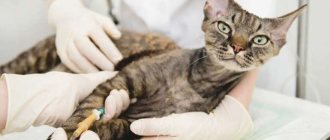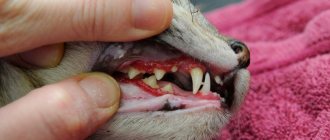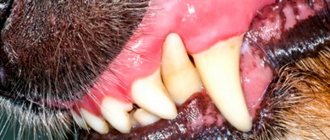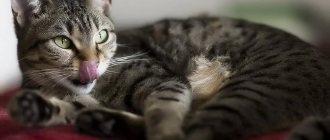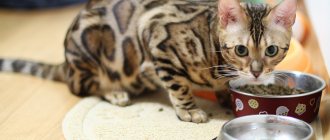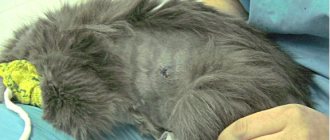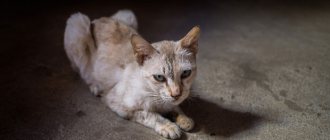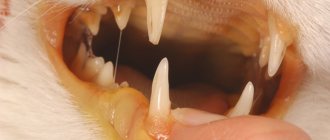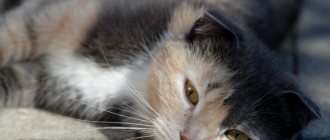The inflammatory process in a cat's gum tissue is called gingivitis. It can affect the gum tissue around one tooth or spread throughout the mouth. Pathology precedes the development of periodontal disease and stomatitis (inflammation of the mucous membranes of the mouth, including the pharynx). The main factors for recovery are timely detection of the disease and prevention of plaque and tartar in the pet.
Our article will help you identify the symptoms of gingivitis in a cat at home. You will learn about the details of diagnosing the disease and subsequent treatment of the animal with medications, medical procedures and folk remedies.
What is gum disease
The pathological process that develops on the mucous membrane of the gum tissue is called gingivitis. The disease affects the area of one or several teeth at once.
Kinds:
- primary – symptoms manifest themselves, for example, due to poor oral hygiene;
- secondary - symptoms develop as a consequence of the underlying disease, which is usually of an infectious nature.
In any case, the infection spreads into the deep layers of muscle tissue, approaching ligaments and bones. This leads to slow destruction and complications - periodontitis, periodontal disease, periodontitis, tooth loss or abscesses. The consequences of gingivitis are difficult to treat.
The note! Inflammation of the gums brings many problems to the animal. In most cases, the cat stops chewing food normally and suffers from pain. Sometimes the disease reaches the point of exhaustion.
What does red gums look like in a cat?
Normally, the gums of an adult cat have a uniform pale pink color, and there are no defects in the mucous membrane covering them. The color of the gums is actually an indicator of a cat's health, as they can be easily seen if you lift your pet's lip. Red gums always indicate the development of gingivitis. If the redness already spreads to the palate, tongue, inner surface of the lips, cheeks, palatine arches, we are talking about stomatitis, diffuse inflammation of the oral mucosa.
Redness of the gums can vary in severity: from dark pink to crimson-red. It is usually localized in the projection of the roots of the teeth, forming a characteristic frame of the dental arcades. In some cases, redness may affect the area of one or more teeth.
Redness of the gums is often accompanied by swelling of varying degrees, with the gums beginning to overhang the crown of the tooth. Its mucous membrane becomes less shiny, looser, and may bleed easily when touched. Against the background of a reddened mucous membrane, cloudy purulent discharge and filmy fibrinous deposits can be seen; in advanced cases, islands of necrosis are identified.
Defects may appear on the mucous membrane that violate its integrity - erosions and ulcers of various shapes, depths and sizes, the appearance of which, as a rule, determines the cause of their occurrence.
If you evaluate the condition of your teeth, then in most cases redness of the gums is accompanied by the presence of plaque or even tartar. The latter is formed as a result of hardening of dental plaque, the deposition of mineral salts from saliva into it and tight fixation to the tooth enamel. Plaque begins to form in the area of the tooth neck, which is covered by the gums.
Gingivitis often coexists with tartar and plaque
Gums can not only turn red
Regular monitoring of your pet's gums is important to gather information about your pet's health. In addition to redness of the gums, the owner may notice other changes in their color:
- Pallor. At the same time, when pressing on the gum for more than 2 seconds, a white spot remains - this indicates a violation of blood circulation in small vessels and is a terrible symptom of shock.
- Whiteness - may occur with: severe anemia, which developed as a result of: blood loss;
- infectious disease, especially feline viral leukemia;
- massive helminthic infestation;
- very poor nutrition;
- acute asphyxia: when foreign bodies enter the upper respiratory tract;
- hemolytic conditions: infectious diseases, for example, hemobartonellosis;
The presence of one or more bluish spots on the gums indicates their injury with the formation of a hematoma.
Such a wide range of changes in the color of the gums is due to the fact that capillaries approach the surface of their mucous membrane closely, so it is possible to evaluate both the parameters of capillary blood flow and gross changes in the composition of capillary blood. Any change in the color of the gums, especially a sharp one, is a reason for an immediate visit to the veterinarian; If the change in gum color is combined with a disturbance in the cat’s well-being, the visit should be an emergency.
Photo gallery: gum color change
With jaundice, the gums are stained yellow by the pigment bilirubin.
With severe anemia accompanying viral leukemia, the gums become almost white
With gingivitis, the gums turn different shades of red.
Causes of inflammation in cats
There are a variety of causes that lead to the appearance of gingivitis. The main external factor is chemical and mechanical damage to the shells. Getting sharp objects, bone fragments and aggressive substances into the mouth are common causes of injury and further infection of wounds. The mucous membranes of the gums are thin, so overexposure leads to injury.
Other causes of inflammation in cats:
- problems with bite – crowded teeth press down soft tissues, which provokes the formation of ulcers;
- lack of ascorbic acid and retinol in the body - vitamins on which the state of the immune system depends;
- dental diseases - untreated caries leads to the leaching of minerals from the enamel and destruction of dental tissues;
- infectious, inflammatory diseases – rhinotracheitis, calcivirosis, panleukopinia, chronic gastrointestinal disorders;
- diseases of the endocrine system - diabetes, hypothyroidism.
The most common cause of gingivitis is insufficient oral hygiene, as a result of which food gets stuck in the interdental areas, at the border of teeth and gums. These residues provoke the proliferation of microbes. Dense, hard deposits form, tartar and gum inflammation appear.
Symptomatic treatment
If there is any change in the color of the gums, you should take your pet to the vet. Many of the pathologies that are accompanied by a change in the color of visible mucous membranes are serious, some require long-term treatment or emergency care, and some can cause the death of a pet.
The veterinarian will help you correctly determine the cause of the color change and select adequate treatment. In some cases, an ultrasound, complete blood count, computed tomography or x-ray may be required for a more accurate diagnosis.
So, if a foreign body gets in and it is impossible to remove it mechanically, an emergency operation is performed.
For bites and allergic reactions, antihistamines are recommended. In case of poisoning, gastric lavage is effective.
In the case of pathologies of internal organs, the cause that caused the change in gum color is treated. Prescribe a therapeutic diet if necessary.
For diseases of the oral cavity, ointments, sprays and solutions of medications are prescribed. The cat's mouth is treated with cotton swabs.
Injuries are treated locally, decongestants and cold compresses are prescribed to the site of bruises.
List of gum diseases accompanied by inflammatory processes
The inflammatory process also occurs with various pathologies in the oral cavity.
List of gum diseases:
- Periodontitis is a widespread inflammation that affects the gums and surrounding areas. The consequence is that the soft tissues sink, exposing the roots of the teeth, causing them to become loose.
- Periodontal disease is the destruction of the periodontium (ligamentous apparatus, tissues around the teeth). Develops slowly, with a chronic course. Gingivitis usually appears as an intermediate stage of the pathological process.
- Indolent ulcer is a disease that affects the upper lip of an animal. In this case, the formations are small and slightly concave. Inflammation gradually spreads to neighboring tissues, including the gums.
- Lymphocytic-plasmacytic stomatitis is a disease about which little information is yet known. Sharp and severe pain, wounds, and ulcers appear on the soft palate. Often accompanied by gingivitis.
Inflammation is dangerous if not treated in a timely manner. If gingivitis and any of the listed diseases are started, the pathological process will quickly spread to the pharynx, larynx, tonsils or other organs and tissues.
What is anemia?
Anemia is a medical term that describes a decrease in the number of red blood cells in the blood, hemoglobin, or both. It is not a specific disease, but a syndrome that results from many other diseases and disorders. Hemoglobin carries oxygen to the cells and tissues of the body, and a patient suffering from anemia will experience symptoms associated with a lack of oxygen.
Red blood cells are produced by the bone marrow and then enter the bloodstream, where they circulate for about two months. As they age or become damaged, they are removed from the blood to make new ones from their components. The number of red blood cells in the blood may decrease due to decreased production or increased loss.
Symptoms and first signs of the inflammatory process
An early symptom that accompanies gum inflammation is an unpleasant odor from the mouth. The discovery of bad breath in a pet should immediately alert the owner. Other characteristic signs of the inflammatory process:
- increased production of saliva;
- swelling and redness of the gum surface;
- the severity of the border between soft tissues and teeth;
- decreased appetite due to pain when chewing;
- apathy, inactivity, lethargy.
Sometimes cats develop a fever and their lymph nodes become enlarged. In advanced cases, the mucous membranes turn blue, swell and hang over the teeth. Sometimes gingivitis is complicated by bleeding ulcers.
The note! The lymphocytic form is accompanied by salivation, a strong odor from the mouth, and difficulty swallowing. Upon examination, ulcers are found on the soft tissue membranes, redness, and signs of inflammation.
Veterinary clinic of Dr. Shubin
Definition
Lymphoplasmacytic stomatitis is a chronic inflammatory proliferative disease of the oropharyngeal mucosa with variable involvement of the gums, palatoglossal arch (pharynx), base of the tongue, larynx, palate, and caudal part of the pharynx.
This form of stomatitis is a descriptive term indicating inflammation and proliferation of the gingival and oral mucosa. Lymphoplasmacytic stomatitis is more of a histopathological description of biopsies for this form of gingivostomatitis. Feline lymphoplasmacytic stomatitis is described under multiple synonyms: caudal stomatitis, feline gingivitis-stomatitis-pharyngitis complex, plasmacytic gingivitis and stomatitis, lymphoplasmacytic glossopharyngitis, lymphocytic laryngopharyngitis, FGS, etc.
Causes
The exact cause of caudal stomatitis has not been determined; there are many causative factors that can act either individually or in combination. Lymphoplasmacytic stomatitis is generally considered as an idiopathic condition, after excluding viral, bacterial and mechanical (traumatic) factors. The main suspected cause of this stomatitis is a hypersensitivity reaction to oral tissues, in which bacterial antigens act as haptens.
Feline calicivirus and feline herpesvirus are isolated from many animals affected by caudal stomatitis, however, these viruses alone do not cause this form of the disease. Some authors consider feline coronavirus to be pathogenic, but this conclusion requires further research. Most cats with caudal stomatitis are free of retroviruses, however, FIV or FeLV may aggravate the oral lesions. Infection with Bartonella henselae has also been considered as a likely cause of caudal stomatitis, but the evidence is very conflicting.
In cats with chronic caudal stomatitis, serum levels of IgG, IgM, and IgA are significantly increased, and the concentration of IgA in saliva is reduced; this may serve as the main pathogenesis of caudal stomatitis. To date, it is assumed that the main role is played by an excessive inflammatory response of the cat's body (immune) in response to the formation of bacterial dental plaques.
Clinical signs
The average age of onset of the disease is 7 years. The medical history often reveals dysphagia, halitosis, decreased appetite with possible weight loss, and ptyalism. Examination of the oral cavity reveals a variety of changes, including raised, ulcerative, proliferative, and/or erythematous lesions that may contain both ulcerative and proliferative components. Typical localization of lesions is the palatoglossal arch (pharynx), around the teeth, the root of the tongue, along the caudal edge of the frenulum of the tongue. Additional affected areas may include the caudal pharynx, nasopharynx, laryngeal mucosa, and the junction of the buccal mucosa and tongue. The main clinical sign that distinguishes gingivostomatitis from periodontal diseases is the presence of caudal stomatitis, i.e. the occurrence of a lesion separate from the teeth.
Laboratory blood tests may reveal leukocytosis and moderate anemia of a chronic disease, as well as an increased content of total protein.
Diagnosis
The presumptive diagnosis is characteristic clinical manifestations. The final diagnosis is based on histopathological examination. Histologic findings include a variable mixture of lymphocytes and plasmacytes, with a predominance of lymphoid cells beneath the eroded epithelium. Additional inflammatory cells in the form of eosinophils, macrophages, and neutrophils are likely. Repeated examination is necessary to exclude neoplasms.
Cytological samples are often poorly diagnostic due to the accumulation of cellular and bacterial debris on the surface of the lesions.
Differential diagnosis
• Eosinophilic granuloma complex. • Periodontal diseases. • Neoplasia (squamous cell carcinoma, lymphosarcoma). • Foreign body of the oral cavity (linear at the root of the tongue or penetrating in the form of wood chips, parts of plants, etc.). • Secondary stomatitis due to viral infections (VLK, FIV, calicivirus, herpesvirus) • Immune-mediated diseases – SLE, pemphigus complex.
Treatment
In therapy, it is likely to use a variety of methods, both individually and in combination.
Professional cleaning of tartar
Removing tartar followed by teeth grinding brings significant relief; as a rule, therapy begins at this point.
Immunosuppressive therapy with prednisolone
Prednisolone – initial dose 1-2 mg/kg x 1-2 times a day. In this dosage, the drug is prescribed for a week, followed by a gradual reduction and selection of the minimum effective dose. Prednisolone achieves a rapid and pronounced anti-inflammatory effect, pain reduction and appetite stimulation.
Antibacterial therapy
Systemic antibacterial therapy often provides only short-term improvement, and periodic administration of antibiotics is likely. Therapy also uses local preparations containing various antibacterial drugs (about 12% chlorhexidine).
Tooth extraction
Extraction of all teeth located behind the fangs leads to a complete resolution of inflammation in 60%; in other cases, this procedure brings significant relief from the severity of the disease. Tooth extraction is the best long-term strategy because the source of tartar accumulation that contains the largest amount of antigens is removed. This procedure encounters considerable resistance from animal owners and is more often used after failure of conservative treatment with corticosteroids and non-steroidal immunosuppressive drugs.
Non-steroidal immunosuppressive drugs
It is possible to prescribe drugs such as cyclosporine, azathioprine, chlorambucil, aurothioglucose, either individually or in combination with corticosteroids (the best therapeutic effect).
Therapy with megestrol acetate
It has a pronounced therapeutic effect, but a lot of side effects are likely.
Laser surgery
Laser surgery is used in patients who do not respond adequately to tooth extraction and immunosuppressive therapy.
Forecasts
The prognosis is variable; more often it is possible to achieve control of the disease but not a complete cure. Some animals do not respond to any therapy and are euthanized.
Photo 1 . Severe ulcerative stomatitis in an adult cat (about 9 years old), a characteristic lesion of the pharynx and root of the tongue against the background of lymphoplasmacytic stomatitis.
Photo 2. Cytological picture of a smear of an impression from the oral cavity of a cat with characteristic lesions; multiple plasma cells are identified in the photo.
Valery Shubin, veterinarian, Balakovo
Purulent form of inflammation
In severe cases, pets develop a purulent form of inflammation - this is a pathological process caused by the growth and reproduction of pathogenic or conditionally pathogenic microflora. As a result, an abscess forms.
Signs:
- putrid bad breath;
- loss of appetite or complete refusal to eat;
- bleeding, loosening of teeth;
- detection of reddened areas of swelling;
- soreness, poor sleep;
- slight swelling of the cheek.
Purulent inflammation of the gums in a cat poses a health hazard due to the possible spread of infection to nearby tissues. The resulting abscess gradually weakens the jaw. The chronic form in older pets increases the likelihood of a bone fracture even with minor stress.
Why is gingivitis dangerous in cats?
In the medical practice of veterinarians, gingivitis in cats is quite common. The disease can be hidden and not show obvious symptoms for alarm. Because of this, a loving owner does not always notice in time that the pet needs help.
Most often, the animal loses interest in its favorite toys and becomes drowsy and lethargic.
If the owner himself does not know how to treat gingivitis in a cat, the situation should not be neglected with the first symptoms of this disease; he should contact a veterinary clinic.
Methods for treating gum disease in cats
The therapeutic measures taken depend on the identified cause of gingivitis. Methods for treating gum disease in cats:
- Cleaning teeth and removing deposits. At the initial stage, when only redness and swelling of the gums are detected, teeth are brushed. If tartar is detected, the doctor removes the deposits. Ultrasound, grinding and antiseptic treatment are used. Abundant deposits from the dentition are removed by mechanical chipping and ultrasound.
- Medicines for plasmacytic-lymphocytic stomatitis. Antibacterial drugs are prescribed in the form of tablets or ointments. Prednisone is used to eliminate the inflammatory process. Interferon is dripped onto the tip of the nose to encourage the cat to lick the liquid. The action of the product is to strengthen the immune system.
- Opening an abscess in soft tissues with a purulent form of gingivitis. After which treatment with antiseptics is performed. If the process is neglected, the cat’s tooth is removed under general anesthesia, and dead tissue in the dental alveoli is cleaned. Antibiotics are prescribed to prevent sepsis.
You should contact your veterinarian when you first notice symptoms of inflammation in your pet. The more advanced the process, the less chance of a complete cure. For example, periodontal disease is an irreversible phenomenon that cannot be eliminated. It is often necessary to remove an animal's teeth.
How to treat anemia?
If your cat's anemia is so severe that it is life-threatening, she will need a blood transfusion. The main purpose of transfusion is to stabilize the cat, but the root cause of the anemia must be diagnosed through examination and testing, and then appropriate treatment must be given.
Treatment is based on controlling the disease that causes the anemia. Treatment may include corticosteroids, antiparasitic drugs, other medications, or surgery. The veterinarian should outline a treatment plan based on your cat's specific needs and test results.
List of drugs, gels and antibiotics
The inflammatory process is always accompanied by the proliferation of bacteria and typical symptoms (pain, swelling, redness). Funds are divided into local and internal.
List of drugs, gels and antibiotics:
- Metrogyl-Denta is a gel for relieving pain and inflammation, the product exhibits antimicrobial properties;
- Dentavedin is a gel for treating the oral cavity, relieving inflammation, and cleaning mucous membranes;
- Zubastik – dental gel for hygiene of the oral cavity, teeth, gums and treatment of tissues during inflammation;
- Chlorhexidine, Furacilin and Miramistin are local antiseptic solutions for rinsing;
- Actovegin, Levomekol - healing preparations for treating affected areas 3 times a day;
- Lugol, Vinilin - means for lubricating ulcers on the mucous membrane;
- Lincomycin, Clindamycin - antibiotics to combat pathogenic or opportunistic microflora;
- Interferon is an immunomodulator to restore immunity;
- Prednisolone is an anti-inflammatory drug.
At the initial stage of the inflammatory process, it is recommended to add folk remedies to medications. It is common to use decoctions for rinsing or lubricating from chamomile, strawberries, and oregano. Herbs help relieve inflammation, clean tooth enamel, and the surface of gum tissue. However, when using only folk remedies, the result will be barely noticeable.
Diagnosis and treatment
Since gingivitis has characteristic symptoms, the disease cannot be confused with another ailment upon visual examination. However, subsequent therapy depends on the setting of the form of gingivitis. To do this, you will need to perform a number of studies and tests.
What tests will the doctor prescribe?
To determine the form and extent of tissue damage, a smear analysis from the diseased gum and a blood test are prescribed. Tests help identify the causative agent of infection and select the right antibacterial drug for treatment. If necessary, an x-ray of the jaw is performed.
After identifying the plasmacytic-lymphocyte form, it will be necessary to examine the gum biomaterial using a microscope. The prescription of further therapy for complete victory over the pathology depends on its result.
Procedural treatment
For a quick recovery, it is important to regularly clean your cat's mouth and teeth. In a veterinary office, curettage of gum pockets and gums is performed, dead tissue and pathogenic plaque are removed.
In advanced cases, the doctor may suggest surgery to remove teeth (extraction). Total extraction (removal of all the cat’s teeth) is also used. This procedure does not have a strong effect on the pet’s eating habits, even if he eats exclusively dry food. You need to understand that if your pet is in severe pain and completely refuses to eat, the best solution for the cat’s future life and health is to follow all the doctor’s recommendations.
At home, you should also clean your teeth daily with a toothpaste prescribed by your doctor. Products intended for people should not be used to remove plaque. Dental hygiene should be performed with a clean cotton swab or a special toothbrush for animals. It can be purchased at a veterinary pharmacy. Small children's toothbrushes also have soft bristles. They can also be used to clean your cat's teeth.
In veterinary clinics, teeth are cleaned of tartar using ultrasound. The procedure is painless and harmless.
Drug treatment
To quickly eliminate pathogenic flora on tooth enamel and gums, powerful anti-inflammatory drugs and antibiotics are prescribed. In severe stages, injections are prescribed.
Interferon is prescribed to correct the functioning of the immune system. The doctor prescribes Prednisolone as an effective anti-inflammatory medicine. The dosage is prescribed individually by the attending physician.
Antibiotics used:
- Clindamycin.
- Lincomycin.
- Convenia.
- Stomorgil.
Important! All appointments should be made only by a qualified veterinarian. Otherwise, you can harm the health of the animal. It is important to calculate the dosage correctly to avoid increased side effects.
You can treat the oral cavity of representatives of the cat family with Metrogyl Denta medicinal paste. This medicine does not cause salivation or allergies and is well tolerated by the cat's body.
Anti-gingivitis pastes Zubastik and Dentavedin have also been specially developed for animals. These products are sold in veterinary pharmacies. They contain non-hazardous herbal and medicinal components that actively destroy the growth of harmful bacteria, stop infection and relieve pain. The product must be applied twice a day to the cleaned surface of the gum tissue and tooth enamel. For processing it is convenient to use a cotton pad or cotton swab. The duration of such treatment takes about two weeks.
The cat’s oral cavity is also treated with antiseptics - a solution of Chlorhexidine and Miramistin. These drugs kill pathogenic microflora and inhibit the spread of infection.
The drug Chlorhexidine is a powerful antiseptic that is used for dental treatment of people. It is suitable for both cats and dogs. The structure of gingival tissue and tooth enamel of the lesser brothers is similar to the structure of humans, therefore, veterinary medicine often uses remedies from medical practice.
Chlorhexidine has an anti-inflammatory effect, quickly heals wounds and cracks in the palate, and helps preserve the animal’s teeth. The antiseptic stops the activity of pathogenic bacteria, causing the manifestations of infection to decrease and tissue restoration to occur.
Folk remedies
How to cure pathology? The initial stage of the disease can be eliminated through complex treatment with medications and folk remedies. When gums are damaged, decoctions of medicinal chamomile, oregano, and strawberries are used. Herbal raw materials can be purchased at a regular pharmacy. It will take at least two to three weeks to treat the oral cavity, however, the chances of recovery if you use only folk remedies are low.
Recipes:
- Dried chamomile flowers are brewed with boiling water and left for about an hour. You can boil the broth for 5 minutes if desired. The resulting product is infused and filtered through cheesecloth. The tip of a cotton swab is moistened in the healing liquid and wiped the gums and enamel of the animal’s teeth. It is necessary to act carefully, otherwise the animal will begin to show anxiety and will not allow the owner to treat the oral cavity.
- Strawberries have a good anti-inflammatory effect. Dry raw materials are poured with boiling water, boiled on the stove and infused. Next, the decoction is filtered and used several times a day to treat the palate, teeth and gum tissue (as in the example above).
Cat feeding diet
If you have gingivitis, you will need to change your cat's diet. The main rule is warm and soft food. With the industrial type of nutrition, dry food is pre-soaked in water, and canned food and pates for weakened pets are included in the diet. Menu for natural feeding:
- broths with fish or lean meat;
- slimy oatmeal, rice porridges;
- boiled meat or fish in the form of puree;
- cottage cheese, natural yogurt, kefir;
- vegetable puree.
You will need to exclude bones, hot and cold foods, and solid foods (dry pellets, meat with streaks or large fibers, raw vegetables) from your pet’s diet. Fried, salty, fatty foods and sweets should always be absent from a pet’s diet.
Features of nutrition during treatment
The predominance of dry and carbohydrate food is one of the causes of gingivitis, so during the treatment period the pet’s usual diet is adjusted:
Important! The basis of nutrition is soft puree food.
- exclude cereals and dry food with a high content of starch, sugar, flour;
- three times a day they feed soft food with a high protein content - broth, pureed vegetables, meat puree;
- exclude snacks, since after eating the cavity is treated with gels and sprays;
- enrich the diet with vitamins A and C;
- probiotic complexes help improve immunity.
The basis of nutrition is soft puree food
Measures to prevent gum disease
Inflammation of soft tissues in the oral cavity often leads to complications if treated incorrectly or untimely. Therefore, doctors recommend preventing the occurrence of a pathological process.
Many diseases have few or no cures. Measures to prevent gum disease:
- regular care of the animal’s teeth, gums, and oral cavity;
- using chewing toys to strengthen teeth;
- adding special food to the diet to remove plaque;
- exclusion of bones from the pet’s diet;
- preventing oral infections;
- periodic observations by a veterinarian.
Prevention measures
Cats are good at masking any discomfort, so owners often have no idea about their pet’s painful condition. Therefore, one of the important preventive measures is an annual examination by a veterinarian. Gingivitis detected in the early stages can be treated, whereas, when it develops into periodontal disease, it can lead to disastrous consequences.
Sanitation of the oral cavity in the clinic
A visit to the veterinarian will allow timely sanitation of the oral cavity and detection of teeth affected by caries. They are either treated by burning with silver nitrate or sodium fluoride, or removed. Under no circumstances should such a source of infection be left in the animal’s mouth.
Pet stores offer special cat food to help fight plaque. If the owner is against ready-made food, preferring to prepare the pet’s food himself, then in the same stores you can pick up various dietary supplements, including vitamin and mineral complexes.
Popular Oral Care Products for Cats
To prevent the juvenile form, you should adhere to the following rules:
- Get vaccinated on time.
- Isolate your pet from sick animals.
- Monitor the completeness and variety of your diet.
- Follow the veterinarian's recommendations.
- Observe the condition of the maturing kitten.
Brushing your cat's teeth helps prevent gingivitis. For these purposes, special brushes and pastes for pets are used. Regular toothpaste can cause poisoning to your pet.
How to teach a cat to brush its teeth?
Accustoming your pet to brushing its teeth consists of several stages:
- It is necessary to touch the teeth, gums and tongue in the process of general stroking. Choose a moment when the animal is in a relaxed state and inclined towards affection. Sometimes it takes several weeks for the cat to get used to the owner's touch in the mouth.
- Introducing the toothbrush. Slowly touch the object to the gums, teeth, tongue, allow the pet to sniff it, chew it, etc. They achieve complete addiction to the touch of the toothbrush.
- The procedure for brushing teeth using a special paste. To begin with, it is enough to use a brush moistened with water, and after getting used to it, gradually get used to the toothpaste.
A special brush is used to clean teeth
The following recommendations will help ease the process of getting used to brushing your teeth:
- It is better to start the procedure from a young age;
- in the first stages of training, the claws are cut to avoid scratches;
- the cat is constantly petted, spoken affectionately, and sometimes an assistant is hired;
- They are taught gradually: first they brush with the mouth closed, then when brushing they open their lips, in the last stages the teeth are brushed from all sides, completely opening the mouth.
To prevent the hygiene procedure from becoming a new source of infection, the following precautions must be observed:
- the owner treats his hands with antibacterial soap or any antiseptic;
- After each procedure, the brush should be placed in a special solution for sterilization.
Video - Brushing a cat's teeth
Thus, to successfully treat gingivitis in cats, it is necessary to identify the cause of its occurrence. Timely diagnosis of the disease will allow you to relieve symptoms without negative consequences. By starting the disease, the owner of a pet runs the risk of leaving it without teeth due to the development of a “formidable companion” – periodontal disease.
Read about symptoms and treatment methods for other dental diseases in cats in a special article on our website.
What to do at home
The owner must provide his pet with the most comfortable living conditions and strictly follow the veterinarian’s instructions. You should not self-medicate, as this can aggravate the situation and cause irreparable harm to the cat’s health.
You can alleviate the suffering of a fluffy by using a soda solution or decoctions of medicinal herbs that have a disinfectant and antimicrobial effect. However, traditional methods cannot replace traditional treatment and are used as additional measures.
A decoction of chamomile, oregano, and strawberry leaves has worked well. You need to boil 1 teaspoon of the dried plant, pour a glass of boiling water, and cook over low heat for 10 minutes. Then strain the broth, cool and use to wipe the animal’s mouth.
During gingivitis, a cat usually refuses to eat, since even a small, barely chewed piece causes her pain. However, to defeat pathology, the body needs strength. Your four-legged pet should be fed with special soft food intended for weakened cats, pureed meat and vegetables, meat or chicken broth.
We suggest you read: Is it possible to wash a cat with regular shampoo or bathe it with baby wash?
What causes it?
The reasons can be very different. It's worth starting with the same thing. If the cat’s owners have never taken their pet to a session of removing hard deposits from tooth enamel, the result will be disastrous: plaque teeming with microorganisms will certainly cause inflammation of the gums, or even something worse. This statement is especially true in cases where a cat is injured by eating some fish bones or low-quality dry food. An infection that has entered the gums develops and causes a strong inflammatory reaction.
But all these are completely understandable and obvious factors of occurrence. It is much more interesting that sometimes gingivitis develops in cats with excellent teeth, a complete absence of tartar, and whose diet consists exclusively of high-quality canned food, or even raw meat. Where does their gum inflammation come from? Firstly, even with a good, but unbalanced diet, there may be a lack of vitamins. Of course, ascorbic acid is still synthesized in the cat’s body, so it doesn’t lead to full-blown scurvy... But even the existing disorders are enough for the opportunistic microflora of the oral cavity to “reclassify” as pathogenic.
Forms of the disease
A severe form of the disease is the plasmacytic-lymphocytic form . It is caused by various viruses - rhinotracheitis, panleukopenia, hyperreaction of the immune system. This form has complications. The gums begin to bleed and swell. Without treatment, complications develop.
The dental form of the disease is accompanied by sore gums, bleeding and swelling. Diseased tissues become bluish in color. The submandibular lymph nodes begin to swell. Unlike the plasmacytic form, the disease is caused not by a virus, but by accumulated plaque. The dental form is treated faster and rarely causes complications.
Juvenile gingivitis is a form of the disease characteristic of cats under the age of 1.5 years, also called juvenile gingivitis. Inflammation of the gums and pharynx occurs immediately after the eruption of permanent teeth. If left untreated, periodontitis may develop.
